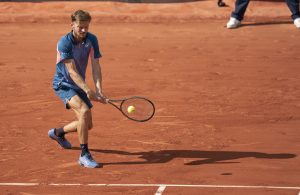If you’ve been following the NextGen ATP Finals taking place this week in Milan you would have noticed an unusual scoring system, amongst many other changes. To summarize the main changes quickly and briefly they are as follows: first to four games a set, best of five sets, no ad-scoring, no let rule, electronic line calling, and a shot clock between points. The ATP themselves have called this a “trial.” Whilst I commend the ATP for looking ahead at the future of tennis, it’s mainly a terrible way to trial new rules, many which I believe will never be implemented on the main tour.
To begin I want to talk about the event itself. It features seven of the top eight top 21-and-under players (Alexander Zverev withdrew in preparation for next week’s World Tour Finals in London) and an Italian wildcard, Gianluigi Quinzi, ranked #306. This is the last tournament of the year for many of these players and after playing the usual format of events this whole calendar yet what’s the use of ending the season with a one-off event like this?
When several new rules are being implemented to players who are new to them, there’s going to always be unfamiliarity. Throw in a whole bunch of them together and it’s going to feel like a completely different sport, and that’s sort of what these NextGen Finals feel like. Yes, it’s still two players across the net from one another hitting a tennis ball but with coaching, no ad-scoring, “let aces,” and first to four games a set, the whole flow of the game is different.
A few of these new rules could “improve” tennis for sure, but when it’s among so many other rule changes it’s going to be hard to specifically see what does and doesn’t work. For example, when you have best of four game sets paired with no ad-scoring, if you want to see if one works it should be tested alone as currently they just influence one another. As it stands during this event, we have had 14 sets under 20 minutes with a few coming at 14 minutes. The ATP has wanted to speed up play with these rules, but with both in play (alongside the shot clock) it’s only led to a fair amount of sets being quick and lifeless.
When it comes to specific rules, the no-let rule was tested on the ATP Challenger Tour for three months back in 2013. Did it amount to anything? No. After the trial ended it was never seen again with many players stating they did not like the rule. If this was the result of three months and hundreds of players trialling it, then what difference is eight youngsters playing with these new rules for a week going to make?
If we look at the current tennis rules “…a maximum of 25 seconds may elapse from the moment the ball goes out of play at the end of one point to the time the ball is stuck for the next point.” In Milan they’ve added a shot clock so this rule is enforced, which is all well and good. However, what tennis should be striving for is an average maximum of 25 seconds between points. Giving players the same amount of time after an ace and a 60 shot rally just doesn’t make any sense logically. It should be up to the server to decide how long they want to take; if they want to take 10 seconds after an ace and 30 seconds after a long rally what’s the issue providing the average time in between points doesn’t exceed 25 seconds? Isn’t that better than players taking 25 seconds after a short non-grueling rally just because they can?
The only one I believe can be tested relatively well here is the electronic line calling system, and so far it seems to be working great. The only issue is most events these days only have a handful of courts with Hawk-eye, and that has been out for over 10 years now. It could be years before we see this used in events, and even then it probably won’t be on every court–once again leading to players on bigger courts having an advantage.
Ultimately, there’s no doubt new rules are worth trying, but the way the ATP is trialling them is just asking for them to be disregarded. If some of these rules can have a positive effect on the game they have to be tested on the regular ATP Tour (or, like in 2013, on the Challenger Tour), where there are more than eight players through a period of several events. By testing these rules in abundance and off the regular tour, it’s only likely going to end like the no-let rule did on the Challenger Tour years ago–which is a shame for those few changes that could actually improve the game.






